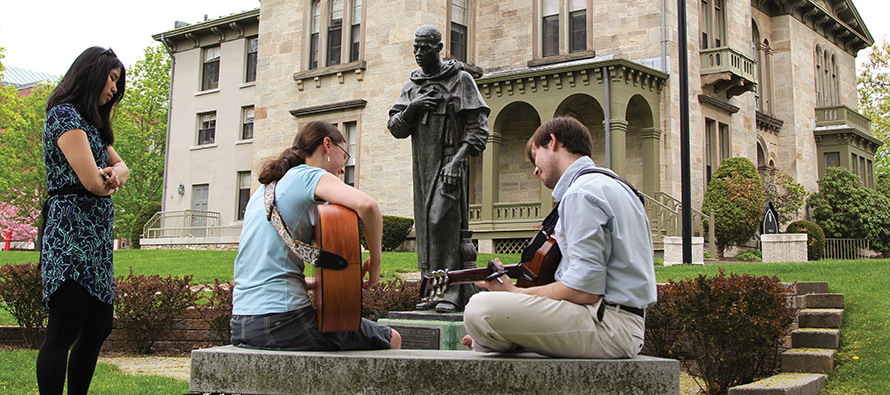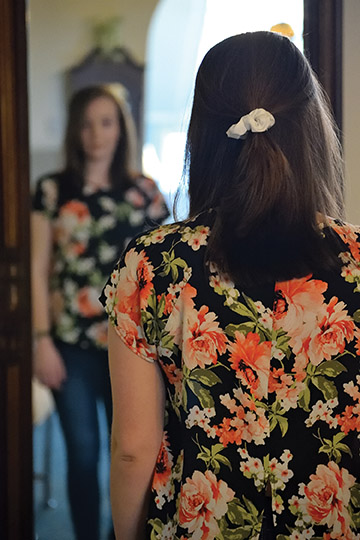Heaven help you in your discernment

Excerpts from Becoming Who You Are, by James Martin, S.J. Copyright © 2006 by James Martin, S.J. Paulist Press, Inc., New York/Mahwah, N.J. Reprinted by permission of Paulist Press, Inc., www.paulistpress.com.
THE MOST IMPORTANT spiritual insight I’ve learned since entering the Jesuits is that God calls each of us to be who we are. “For me to be a saint means for me to be myself,” said Thomas Merton. As a result, holiness consists of being true to the person God created. In other words, being holy means being your true self. And besides the life of Jesus of Nazareth, the best illustration of that can be found in the lives of the saints.
I know many readers might groan (inwardly or outwardly) when they hear that. Because, unfortunately, for many people the lives of the saints are considered overly pious and largely irrelevant legends. It can seem almost impossible to relate to people known primarily as marble statues or stained-glass windows. You look at a statue of, say, Saint Thérèse of Lisieux, the “Little Flower,” in her Carmelite habit, holding a bouquet of roses and looking heavenward, and it’s not hard to think, “What does that have to do with my life?”
But it’s important to remember that the saints were human beings, which means that they sinned (frequently), doubted (sometimes), and wondered whether they were doing the right thing (more often than you would think). As anyone does, the saints struggled with casting off the vestiges of their false selves and becoming who God wanted them to be.
As an aside, I’m using the term saints in its broadest possible meaning: not simply for those who have been “canonized” by the church (that is, officially declared saints and worthy of public veneration) but also for those holy men and women who may not yet be officially recognized as such. But the use of the term in that way has a distinguished background. Saint Paul, for example, employed the same word to refer to his early Christian companions. “To the saints who are in Ephesus,” begins one letter (Eph. 1:1). “To the church of God that is in Corinth,” he writes in another, “including all the saints throughout Achaia . . . .” (2 Cor. 1:1).
Live the call to holiness
At some point in their lives, each saint realized that God was calling him or her to be faithful in a particular way. Each saint was placed in a different situation and time. Each had a different personality and dealt with life differently. And each related to God a little differently. Just think of the astonishing variety of saints. And I don’t mean simply when they lived, what they did, where they were from, or what languages they spoke. I mean something more basic: who they were and how they lived out their call to holiness.

Some examples: Though both of their lives were rooted and grounded in God, Thomas Merton’s approach to life resembled very little that of Saint Aloysius Gonzaga, a young Jesuit who lived in 16th-century Rome. Merton was forever questioning his vow of stability, his place in the monastery, and his vocation as a Trappist, until the end of his life. Aloysius Gonzaga, on the other hand, the scion of a noble family, seemed always to have known precisely what he wanted to do—that is, become a Jesuit—from childhood. At a young age Aloysius had to battle both his father and his brother to convince them to allow him to enter the Jesuit novitiate. Merton only had to battle himself. Merton’s vocation seemed always to waver. Aloysius’ never did.
Or consider Saint Thérèse of Lisieux, the French Carmelite, and Dorothy Day, the American apostle of social justice and founder of the Catholic Worker movement. Thérèse realized that God had called her to spend life cloistered behind the walls of the convent, while Dorothy Day understood that her invitation was to spend a life on the “outside,” working among the poor in big cities. Each grasped that. But both appreciated ways of sanctity that diverged from their own. Thérèse, for instance, admired the Catholic missionaries working in Vietnam. And Dorothy Day admired Thérèse.
Saint John XXIII meditates on this idea in his book Journal of a Soul, the compendium of autobiographical writings that he kept from seminary until almost the time of his death. In January 1907 he wrote that we must incorporate the “substance” of the saints’ lives into our own. “I am not Saint Aloysius, nor must I seek holiness in his particular way.” None of us, he continued, are meant to be a “dry, bloodless representation of a model, however perfect.” Rather, wrote John, we are meant to follow the examples of the saints and apply them to our own lives.
“If Saint Aloysius had been as I am,” he concluded, “he would have been holy in a different way.”
Holy in a different way
Everyone’s true self is a unique creation of God’s, and the way to sanctity is to become the unique self that God wishes us to be.
Why would Jesus call a tax collector and a religious zealot, and, among his wider circle of disciples, notorious sinners? One reason may have been that Jesus saw each disciple’s ability to contribute something unique to the community. The unity of the church, both then and now, encompasses diversity. As Saint Paul wrote: “Now there are a variety of gifts, but the same Spirit . . . . To each is given a manifestation of the Spirit for the common good. . . . For just as the body is one and has many members, and all the members of the body, though many, are one body, so it is with Christ” (1 Cor. 12:4, 7, 12).
All of us bring something unique to the table, and, through our own gifts, we each manifest a personal way of holiness that enlivens the larger community. We help to build up the “kingdom of God” in ways that others may not. Mother Teresa catches this insight in her most famous saying: “You can do something I cannot do. I can do something you cannot do. Together let us do something beautiful for God.”
This diversity is a natural outgrowth of the role of simple human desire, whose place in the spiritual life is often overlooked. Put simply, the saints had different desires, and those desires led them to serve God in different ways. Such desires affected not only what they did but who they became—their true selves.
These natural inclinations are ways in which God accomplishes his work in various places and in a variety of modes. When I was studying theology, our Jesuit community had a small poster hanging in our living room that offered this little saying about four great founders of religious orders:
Benardus valles,
Colles Benedictus amavit,
Oppida Franciscus,
Magnas Ignatius urbes.
That is:
Bernard loved the valleys,
Benedict the hills,
Francis the small towns,
and Ignatius the great cities.
Each of these four saints found his home in a place suited to his likes and desires and so was moved to accomplish his own particular task. Their individual desires shaped their vocations. Ignatius Loyola, for example, the founder of the Jesuits, would probably have felt his ambitious plans stymied in a small town. And Francis of Assisi, the apostle of the poor, would certainly have gone crazy trying to run a large religious order from a busy office in Rome!
Desire can lead to God
God awakens our vocations primarily through our desires. A man and a woman, for example, come together in love out of desire and so discover their vocation as a married couple. Out of desire a husband and wife create a child and discover their vocation as parents in this way. Desire works in a similar way in the lives of the saints, drawing them to certain types of works, giving rise to special vocations and leading to particular styles of holiness. Henri Nouwen became a priest because he desired it. Thérèse of Lisieux entered the convent because she desired it. Dorothy Day entered the Catholic Church because she desired it. Ultimately, one’s deepest desires lead to God and the fulfillment of God’s desires for the world.
That insight lies behind one of my favorite passages in The Seven Storey Mountain. Shortly after his Baptism, Thomas Merton is speaking with his good friend Bob Lax. Merton tells his friend he wants to be a good Catholic. “What you should say,” says his friend in reply, “is that you want to be a saint.” Merton tells the rest of the story:
“A saint? The thought struck me as a little weird. I said: ‘How do you expect me to become a saint?’ ‘By wanting to,’ said Lax, simply. . . . ‘All that is necessary to be a saint is to want to be one. Don’t you believe God will make you what He created you to be, if you consent to let Him do it? All you have to do is desire it.’”
Following these individual desires and inclinations led each of the saints to a distinctive type of holiness. As Thomas Aquinas, the great 13th-century theologian, said, grace builds on nature. Ignatius Loyola ended a military career in 16th-century Spain to follow God, while Joan of Arc began one in 15th-century France. Dorothy Day founded a newspaper to spread the gospel, while Bernadette Soubirous, the famous visionary of Lourdes, shrank in horror from the idea of her story being publicized in the press. Thomas Aquinas spent his life surrounded by books, while Francis of Assisi told his friars not to own even one lest they become too proud. The multiplicity of desires leads to a multiplicity of paths to God.
A version of this article originally appeared in VISION 2012. Related articles: VocationNetwork.org, “Holiness is for everybody” and “Four-way traffic on the spiritual path.”
Tags
Related
- Tune into your prayer life
- Embody your decisions
- My portable prayer life
- Unravel the mystery of your call
- Religious life today (infographic)
- Religious vocation or family?
- Call within a call: Your vocation and a career
- VOCATION PRAYERS
- 8 questions and answers to your prayers
- A spirituality for every temperament Read More
Most Viewed
- Find your spirituality type quiz
- FAQs: Frequently asked questions about vocations
- Celibacy quiz: Can you live a celibate life?
- Resources for older discerners or those with physical and developmental differences
- About Vocation Network and VISION Guide


 Father James Martin, S.J. is a Jesuit priest, author of numerous books and articles, and editor-at-large of America magazine.
Father James Martin, S.J. is a Jesuit priest, author of numerous books and articles, and editor-at-large of America magazine.